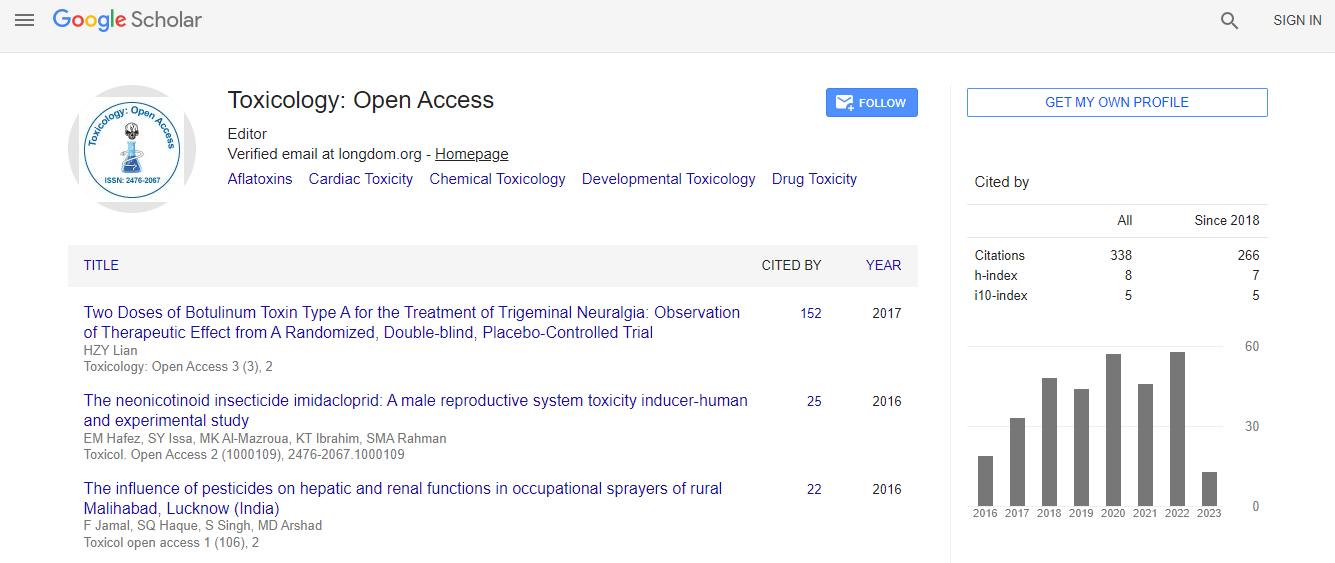Our Group organises 3000+ Global Conferenceseries Events every year across USA, Europe & Asia with support from 1000 more scientific Societies and Publishes 700+ Open Access Journals which contains over 50000 eminent personalities, reputed scientists as editorial board members.
Open Access Journals gaining more Readers and Citations
700 Journals and 15,000,000 Readers Each Journal is getting 25,000+ Readers
Google Scholar citation report
Citations : 336
Toxicology: Open Access received 336 citations as per Google Scholar report
Indexed In
- Google Scholar
- RefSeek
- Hamdard University
- EBSCO A-Z
- Geneva Foundation for Medical Education and Research
- Euro Pub
- ICMJE
Useful Links
Related Subjects
Share This Page
Nations can slash down the infant mortality rate (IMR) to a great extent if they implement proper health care system policies for ante-natal/prenatal and postnatal care for the rural/village level beneficiaries too
14th World Congress on Toxicology and Pharmacology
Swamy K B
Lincoln University College, Malaysia
Keynote: Toxicol Open Access
Abstract
Introduction: Health of a mother and newborn depends not only on the health care received during pregnancy and Intra partum but also during postpartum period. Objectives: To know how the cord care is provided to the Gadaba and Konda Dora newborns, to assess the incidence of homedeliveries, to identify the different categories of care providers and to find out the prevailing components of the traditional cord care practices. Settings & Design: A cross-sectional study was conducted on Gadaba and Konda Dora tribal populations at random from 95 tribal villages in Vizianagaram district, Andhra Pradesh. Materials & Methods: Data were collected from 300 lactating women from each tribe who were aged between 15-45 years through in-depth and face to face interview method. Results: Nearly one fifth (18.0%-20.0%) of the present tribal women reported that the umbilical cord was cut after the delivery of the placenta and majority of the respondents were not sure/unaware of the time of removing the umbilical cord. Most of the Gadaba (80.3%) and Konda Dora (82.3%) tribes used the new shaving blade to cut the umbilical cord. After cutting the umbilical cord, new thread was tied to the stump to arrest the blood flow in 80.3% of Gadaba and 83.0% of Konda Dora newborns. About 96.0% of Gadaba and 95.3% of Konda Dora newborns were applied with variety of oils or ash of vegetative origins and also used different powders to the wound for healing. Conclusion: Some of the present study tribal women have adopted certain unhygienic practices in cutting the umbilical cord with unsterilized unsafe instruments, tying the wound with available material and also applying the cord stump with different substances which are considered as unhealthy practices.Biography
Swamy K B is currently working as a Professor and HOD of Clinical Anatomy, Lincoln University, Kuala Lumpur, Malaysia and has been awarded PhD by Andhra University, India. He has completed his Master’s degree (MS in Clinical Anatomy) from Andhra Medical College, India, DMCh (Maternal and Child Health) from IGNOU, New Delhi, his Medical degree (MBBS) in 1976 (KMC-Kurnool). He has expertise in human genetics, reproductive health and developmental anatomy and also he performed many researches in herbal medicine. He has been the Genetic Counselor for many institutions. He has been the former Founder Anatomist, Professor and Head of the Department for many medical schools in India as well as in Malaysia.
Email:profdrswamy@gmail.com

 Spanish
Spanish  Chinese
Chinese  Russian
Russian  German
German  French
French  Japanese
Japanese  Portuguese
Portuguese  Hindi
Hindi 